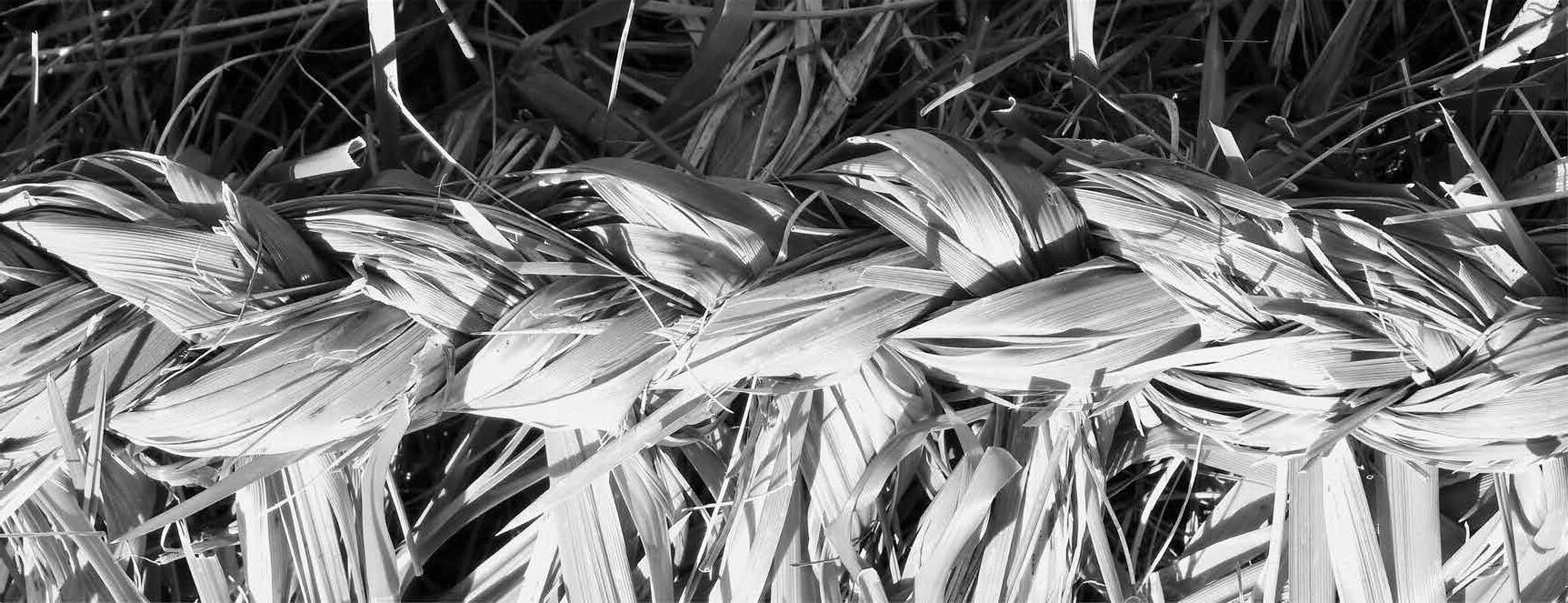




Adunate Word & Design
Ana Fernandez Miranda-Texidor
Andy Hazzard
Aurelia Wills
Colin Crowley
Danny Mansmith
Donna Neuwirth
Erin Schneider
Jay Salinas
John Rosenow
Katie Schofield
Katrin Talbot
Keith Burrows
Kevin Koch
Liz Brownlee
Marcy Huffaker
MaryBeth Barker
Michael Bell
Olly Costello
Omar de Kok-Mercado
Pete Hodapp
Philip Matthews
Ron Lutz II
Sara Greenslit
Sarah Butler
Tanya Carney
Cover art thanks to Peter Makela

What do you see when you envision the year 2074? Perhaps it’s difficult to place yourself there.
With ever-increasing distractions, it can be hard to find the time—to give ourselves the time—to reflect on the future. In the coming pages we invite you to do just that.
In this Volume 2 of IMAGINE, you will experience poems, articles, artworks, and short stories from farmers, artists, geologists, writers, scholars, business owners, and more. Each piece shares a glimpse of the possibilities for 2074.
Weaving in themes of belonging, friendship and family, land and water quality, transformation, migration, and revival, the future imagined by our contributors is hopeful, curious, connected.
With each page we hope you find inspiration and discover the power of art to transport you from current challenges to future opportunities—and perhaps learn something along the way.
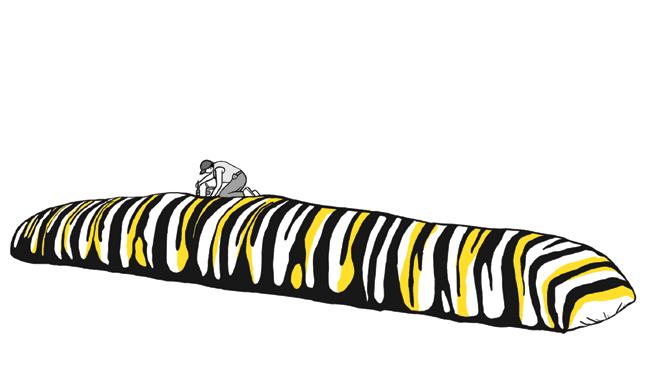
—The Wormfarm Team
by Omar de Kok-Mercado
Under the glow of dawn that broke over skyscrapers like waves against a distant shore, León looked up from his kitchen table, glancing at an old newspaper clipping framed on the wall that read “Navigators of the New Earth: The Renaissance of Grassland Sailors.” Retired now, León had been 35 when he started working as a Biomatrix Engineer for the Vital Ecosystems Revitalized by Dynamic Energy (V.E.R.D.E.) depart ment of the USDA. In 2030, V.E.R.D.E. had ignited a movement to invigorate the Earth’s vital ecosystems through a fusion of dynamic energy solutions and innovative transportation systems within ecological corridors known as Green Rivers.
León walked out on his porch. The air carried a distant scent of renewal, a perfume of earth and flame. He overlooked the perennial transmission corridor that cut through the city like an artery and recognized that today was burn day. His hands, seasoned by years of guiding the land through fire and regrowth, reached down to pick up the day’s paper, the digital ink swirling to display vivid images and stories updating in real-time. The shift in the air that whispered of approaching fire was affirmed by a familiar jingle that came over his house radio, an orchestration of Meadowlark song. Fire was indeed coming to town.
V.E.R.D.E. VOYAGERS: GRASSLAND SAILORS BRIDGE CONTINENTS TO REHOME THE BLACK PANTHER By:
Eliana
Gomez—Environmental Correspondent for Future Fields Magazine, May 9, 2074
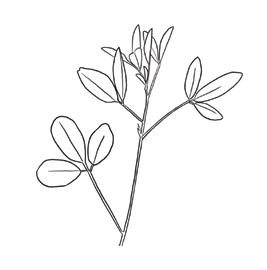
In every ember, a promise, in every ash, a beginning.
Alfalfa
, illustrated by Katie Schofield
In a landmark achievement, the Grassland Sailors of the Vital Ecosystems Revitalized by Dynamic Energy (V.E.R.D.E.) have unveiled the completion of an ecological superhighway, merging the verdant expanses of South and North America. This green corridor stands as a beacon of hope for the majestic Black Panther, guiding it back to its ancestral northern range. Captain Maria Gonzalez, a key architect behind the project, shares, “These pathways are not mere strips of land. They are dynamic ecosystems allowing for mass movement of livestock and wildlife across continental scales.” The transportation sector has played a crucial role, with the corridors facilitating the movement of wildlife, people, and goods in a manner that respects the earth. The translucent and water-permeable solar arrays that dot the landscape, in part, help make this possible.
León sat back down at the kitchen table to read the paper. The birdsong was briefly interrupted by an automated voice: “Prescribed Burn in Progress. Activating House Shields for Duration.” As the shields hummed to life, encasing the house, León mused to himself: In every ember, a promise, in every ash, a beginning. This is our legacy, written in the soil of the corridors we shepherd. A Grassland Sailor Fire Ignition Mantra. He looked out the window and saw smoke tendril up into the azure sky. Shifting his gaze back to the paper, the digital ink flashed: “Prescribed Burn in Progress.” Steam rose from his tea.
León flipped through the paper and found an article titled “Viajeros V.E.R.D.E.: Marinos de las Praderas Unen Continentes Para Realojar el Tigre.” He blinked three times rapidly to activate automated translation:
León remembered standing in the middle of a green river looking up at the installation of a next-generation utility pole: a sentinel bejeweled by self-assembling sails. The sails powered the gravity batteries inside the poles that fed the livestock water pipelines. He found it interesting to read they had coupled solar and water capture into the design.
By integrating prairies and agroforestry practices, the Grassland Sailors have turned these corridors into indispensable sources of sustenance and ecological vibrancy. “We've seen how incorporating food-producing trees and perennial vegetation not only supports our wildlife but also nourishes the communities along these routes,” Gonzalez says, underlining the reciprocal relationship between human and ecological health. “We still haven't finished celebrating the Buffalo resurgence and now we get to add the Black Panther’s success. We are overjoyed. Don't even get me going on nearly eliminating the need for an endangered species list entirely!” Gonzalez adds.
León thought of the installation of triboelectric nanogenerators along major transportation routes. The kinetic energy captured from hooves and human transport was enough to power the food processing and distribution sector, which in recent years, had married with railways via modular railcar innovations that supported the publicly funded livestock herds.
Collaboration with farmers and private landowners, whose lands form the tributaries feeding into the main river systems of the corridors has been paramount. These on-farm habitats are necessary cogs in the ecological network, providing essential refuges and nourishment for migratory species. “Our farmers and landowners are what have made this system work,” Gonzalez states. “Their commitment to maintaining the tributaries has been pivotal, showcasing the profound impact of private stewardship in serving the common good.”
From the kitchen window, León watched as tall flames advanced, a controlled inferno dancing with precision past his protected sanctuary. The shields around his home dissipated. “Chicka-dee-dee-dee-deeee,” played on the house radio, signaling the prescribed burn had passed. Stepping back out on his porch, León looked out over the city, the fire weaving a path of renewal. The spirit of the earth exhaled contently through the smoke rising from its surface.
Omar’s work as a soil scientist and grazier focuses on supporting farmers to incorporate perennials into their farming systems.
You’d love it here now —a world of fence posts, lamp posts, bluebells, dragonfly, dirty fingernails and robots in the fields, birdsong over solar panel buzz
Pollinators have finally figured out how to navigate windmill turbulence, and composting is mandatory in a world that celebrates the perennial, fewer moos, less methane, more whinnies, more horsepower And every farmers’ market still has a poet, typing round little poems down by the egg stand
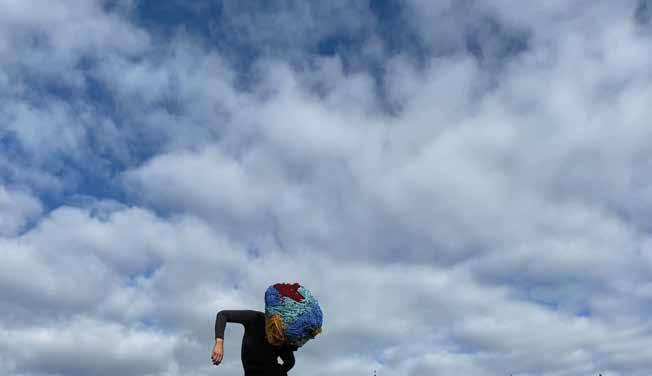
—Katrin Talbot
Katrin is an Australian-born poet, photographer, and violist based in Madison, WI.

Michael Bell is a musician, composer, and professor of community and environmental sociology at UW-Madison.

1. Old fashioned idiom: A mild exclamation of surprise, alarm, dismay, annoyance, or exasperation.
Cordy inhales into a green silence just inside Stomate’s Gate, named for the twin Mulleins, sentinel-like at the edge of her Sauk County Panhandle home. She marvels at the garden, sighs into the hazelnut hedgerow—a refugia where luna moths and countless migrants rest wings in budding catkins, and squirrels and humans feast on its essential seed oils. The air in between feels suffocating, beyond rhizomatic reach. If only she could fully exhale into her newfound emerald existence!
I watch Cordy’s aspirations. She is still breathtaking, bathed in chlorophyllic light, yellow-green-warm after a long day’s shift at Rubisco Foods. Yet the air’s quiet feels amiss and my stroma feels blocked. My branches zig, then zag. My limb-gaze shifts to Cordy’s water, which is supposed to keep her oxygenated. I should know, I’ve been rooting for Cordy for over a year now, ever since the blast at the Plant gave way to a photosynthesis for her and a handful of others who survived the mash-up, along with a pair of goats outside of Ironton. The goats, Boragia and Pleurisy, I hear bleating now and again through the forest edge. They’re thought to bend air-time. I never can place them, but they have an uncanny ability to show up at just the right moment with a freshly washed pound of ATP.
Cordy sputters. Think, Hazel! If I am to respire the battered fragments of my plant body to air and light, I will need to lean into it: the sucrose version of serotonin within that bestows my biochemical ability to listen, maybe even dream new rhizospheres into respiratory being, or so my Fir-bearers foretold me.
I watch Cordy sip sunlit water. What’s amiss, why can’t she exhale? Has the
by Erin Schneider
nitrogen leached into her groundwater? If Cordy can’t complete the redox… well, I already have the oppressive bark of the overstory nagging me to get on with it. And listen, I get it, 300 million years of oxygenating the conditions for life and the trees are tired, ready to grow on strike, and
At a cellular level, she knows that to complete photosynthesis, she needs to breathe into all her body, that she will have to expose the fragments of her heart to light air, and trust in the atmosphere’s shift.
I’m still negotiating space for me and Cordy in mid-arboreal management… I channel my tryptamine-tryptophane spark toward her and wait.
Cordy feels stuck. Every time she tries to breathe, her exhale seems to circulate in stagnant water. She wants to want all her breath, but is struggling to relax into the warmth of fading photons gleaned from the day. At a cellular level, she knows that to complete photosynthesis, she needs to breathe into all her body, that she will have to expose the fragments of her heart to light air, and trust in the atmosphere’s shift.
Yet her sunlit inhales are seized in starch upon release, stubborn and strangely ligneous—as if the forest is closing in on her. The possibility of
an exhale of this build might literally consume her cells or worse, the space around her she’s worked so hard to grow into. Her throat won’t budge. She’ll need a slow release of sugar to go from breathtaking to breath making.
“Ouch!” Cordy yelps and falls into the surprise-embrace of a branching hazelnut hedgerow landing. Dazed, she spits out a sticky husk, red-yellow hollowed where last year’s hazelnut mast was laid bare by some squirrel. Cordy pulses, puzzled through pain.
Fearing an impending ferment, I waste no time mining the substrate level of carbon and oxygen afoot: it’s life or death! I hope the energy overflow diffused from my plant parts to Cordy is enough to support a new gluconeogenesis. That the breath making buildup of pent-up CO2 she experiences will support my theory of energy overflow as an alternative respiratory pathway.
I reach a wilt point and bank on Cordy. I pray my metabolic exchange will support her to assimilate her newfound electron transport enzymes. The forest wavers at the ready for redox…
Cordy stands in a haze. She feels it first, a quantum whisper, a certain shift in Viriditas in being.
Come, be lingulate with me. Step with me in this breath.
We will this Wind together.
˜
Erin is a poet, conservationist, and educator who stewards Hilltop Community Farm in LaValle, WI with her husband Rob.

The sacred farm is still there. Crops are still grown annually and harvested before winter. Winter still comes as does spring, summer, fall. Snow still comes as does the rain. Births of farm animals are still the delight of our successors. The cookbooks sold at rural farmers’ markets reflect the changes in tastes. A meat-and-egg breakfast served over tortillas. Sweets are popular again since the end of the scourge. Myths still have a purpose where people congregate. Beliefs temper struggles of daily life— conflict about which are best has not abated, but there is still a group, smaller than it should be, who find great comfort in treating our need for kindness. They stand out, those whose satisfaction is greater than riches.
—John Rosenow
John is a dairy farmer and co-founder of Puentes/ Bridges, an organization that builds bridges between those who immigrate to work here and Wisconsin’s farming community.



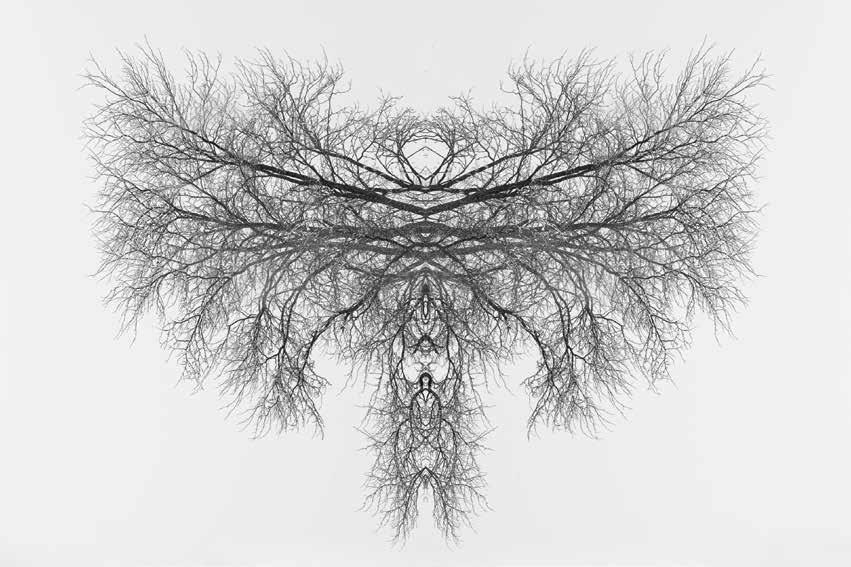
by Andy Hazzard
Scene: An evening walk with visitors in Midlandia, Land that has been Entrusted for 1,000 years for the Purpose of Adapting and Conserving Species, Eco-cultural and Spiritual Experience, Knowledge, and Diversity for the POCS (Period of Climatic Stabilization).
The Guide: “Come, come, first up, let's walk the hill to Babel and we'll glean fruit for dinner!” Everyone laughs, “Why Babel?” “It's a reminder! You're young, Try to Imagine, Intuit, Gno, into it. Citizens United, PFAS, Wars, Criminalization of Reproductive Controls, the Whistleblower Line! I feel your nervousness, discomfort…Force Your Mind to Open
and to more Fully Conceive the Scope of Human Behavior. Nature is Abundant and that's NOT profitable.”
The Healer with the limp turns and says, “Before things Coalesced, every science, art, and philosophy thought its knowledge was The Truth. All, vying to be The One! No Base Reality or Planetary Law. They were all Right; each from a different vantage point, a
dimension of truth. The full picture, what is hidden inside of that which lies in front of us.” The Storyteller chimes in, “They NEVER should have taught us to Read or Write!” Everyone bursts out laughing, someone yells, “The World Word Tree!”
Guide: “Trees!!! Yes, it’s the Oaks 47 years old, and this Hedge has come in so nice. How many species are

here? We are harboring tens of thousands of plants, insects, crops, fungi. The Honeyberries are ready! Where's the bag?” Someone says, “Cultural Membranes were created as an early prototype, right?” Guide: “Cultural Men Braines! Eschew Obfuscation! Yes, exactly!” The Elders giggle, sharing their stories about #%. The Youngers are confused. One says, “Was it a Portal?” Another: “Consensus? Eclipses?” The Astrophysicist says, “Planetary Alignments caused Mind Sets to click from Linear to Logarithmic. #% meant Sovereignty, Solidarity.”
The Alchemist says, “We Orchestrated the Chemical Maps.” Someone else says, “Remember, Youngers, Individual Immersive Learning hadn't arrived, we PROVED IT, and marched off shouting Bygones!”
agrees, “See, the power of Coalition, and… Functional Education!” A Performer turns abruptly and says, “You… took the Money Away, and that was the least of it, you removed the Admiration.”
The Guide: “Yes. We Unbound our Lexicon and our Lives, from the Lies. We Removed Our Creativity from the Sociopaths of Humanity.” Heads nod. A Philosopher says, “Occam's Razor, the simplest answer is usually the best, it’s the Swiss Army Knife of lenses, apertures, guides. Anybody got one? Ooo, look at these Raspberries! The Razor of Food, perfect example!”
Everyone thought the Singularity meant, Oh, we’ll all be the same. It was the opposite, obviously, the only person occupying your viewpoint is you.
A Herdswoman quips, “Everyone thought the Singularity meant, Oh, we’ll all be the same. It was the opposite, obviously, the only person occupying your viewpoint is you.” Guide: “Look over that gate, for herbs!” Everyone begins chatting: “This arbor over the gate, what's it made of?” “Herbs look great!” “Oooh, Garlic and Ginseng!” “It's made of itself, we're always experimenting in species balance.” “Grab more herbs before the sheep come eat them.”
An Elder Ethno-Veterinary Dr. pipes up, herbs in hand: “Communications spaces were dominated by the worst, it was Suffocating and CrowdSourcing was not an Ecosystem…YET.” Somebody says, “Taste this!” A bowl of fresh flowers and herbs of mint, oregano, thyme and fruit is passed among the group.
A Legerite says, “Materialism…Most toys wins!" A Mazlovian remarks, “Yes, and Folx Health, Insurance… Trusts. Or was it those RRIT Risk Reduction Investment Trusts? Perpetual Trusts birthed thousands of places like this.” One says wryly, “Controlling Consciousness was like holding back Billions of Hurricanes...” The Woodsone Bellows, “It spread like wildfire, ironically, at the time of the wildfires and Climate Hoax Collapse!” The Tooler
An Agrarian asks, “How many types of farming are here?” The Guide: “Thousands, but it's a global stew of techniques. All knowledge is conserved, physical examples, documents, testimonials, story, song. We began with Elder and Indigenous knowledge. We are the Keepers of the Free Ways. People come, Immerse themselves in Living, Learning, The Choice. Many leave to begin another farm or use their knowledge in The Great Tuning… Ah the Tower! Youngers first, we're right behind you.”
The Sun was setting, mist was seeping from Creek and Pond. Words set aloft as they ascended. Boundaries, Songs, Dissolution, Dinner, Metamorphosis. A Medicine Elder recounted realizing that communicating and teaching needed to… they were reaching the top.
“Face East! You have experienced your first walk here! Looking down the hill from whence you came, our Past is now in front of you. The Golden Hour of Change, the land around you as far as you can see is part of the movement. Each on their own terms, built on the Maslovian system redeveloped in the early 20s, just before the Coastal Migrations Commenced...”
Andrea started Hazzard Free Farm in 2007, which grows highquality heirloom grains in the organic tradition and uses age-old stone-grinding techniques.


This notice uses the archaic medium of “letters printed on paper” as a consideration to those who reside in technology deserts and to accommodate those Centenarians who have opted out of installing the NeuraLink™ to receive notice of the following updates.


Sustainable Agriculture Research and Education (SARE)
Quarterly Report, April 2074
Attn: Regional Stakeholders
The association of Human Resource Centers (HRCs) reported record yield in FY2073, marking an increase in both inputs and outputs for the seventh consecutive year. Sustained growth is especially welcome since the reorganization of the HRC system into a series of Mondragon-style cooperatives with the help of a SARE grant in 2062. Changes were instituted after operations were halted during the MilkBoneGate scandal and facilities were seized from the notorious Family Dollar General Tree cartel.
HRCs are now compliant with the carbon bank guidelines and operate in the black. Each site has a family-friendly Memorial Sculpture Park (with local vegetarian food kiosk) in which personalized ephemeral monuments are created with a team of specially trained Mortuary Artists. Upon delivery of the Beloved Feedstock, a celebration of life and design charette helps the family devise the most appropriate memorial for their future stable humus. When the process is completed within 12-14 months, depending upon the BMI of the Feedstock, the family is presented with approximately 25 kilograms of crumbly, sweet-smelling Loved One in a custom-designed, hand-printed hemp sack, with the option to install the non-compostable bits into the Community Ossuary. Keep up the good work, Compañeros!
The final phase of the historic Land Back Initiative (LBI) has been launched throughout the Mississippi–Wisconsin Rivers Cultureshed. This was commemorated by a ribbon-tying ceremony on the equinox at the confluence of the Ouisconsin and Mississippi Rivers, featuring representatives of the 11 First Nations of the region along with leadership of the New Federated States of Norteamericano. A team of SARE grantees helped develop and conduct the ceremony.
Signed into law in 2047 in the second Sasha Obama administration and implemented by the Department of Agri/Culture under Secretary Chase Buttigieg, the LBI was developed following the work of the Truth & Reconciliation Commissions (2039-45) which established a revised, fact-based historical understanding of the “settling” of the Continente Norteamericano that took place in the latter half of the 2nd Millennium CE. Those findings led to the subsequent Algonquin Confederation v. BLM case in which SCOTUS Chief Justice Cassidy Hutchinson wrote for the majority that, “...due to massive, documented, and long term treaty breaking, restoring of the right of indigenous people to move freely across the land shall not be infringed.”
The eventual removal of 51% of the USGS geodetic markers effectively “eras[ed] most governmental boundaries across what have been Native lands since time immemorial.” SARE has been proud to support the effort.
Grazing systems with Elk & Buffalo. Nutria adapt to virtual fencing. How visiting the quadrennial Farm/Art DTour became a “must” for those seeking the Presidency.
Ghost writer Jay Salinas is a farmer, artist, and co-founder of Wormfarm Institute.

The ostensibly for-profit business venture known colloquially as “Wormfarm” (often conflated with its now defunct offshoot, Wormfarm Institute) has somehow managed to lurch into its eighth decade of highly distracted micro farming, though it has never been profitable in the traditional sense. Founded late in the 2nd Millennium, Wormfarm began as a boutique market garden and rural re-education site, training artists and ironic individuals in profound life lessons. The co-founder of Wormfarm
and its primary farmer disappeared around 2035, but enough of “Farmer Jay’s” practices, attitudes, and philosophy could be extracted from a collection of 3,500 weekly newsletters written from 1995-2025 to program an Artificial Farmtelligence-enhanced JayBot 4000 that operates the farm to this day. JayBot runs on cased meats, alliums, and Hazy IPA, and though it plods along persistently, it can be loud, abrasive, and has a tendency for occasional blockage of important tubes.
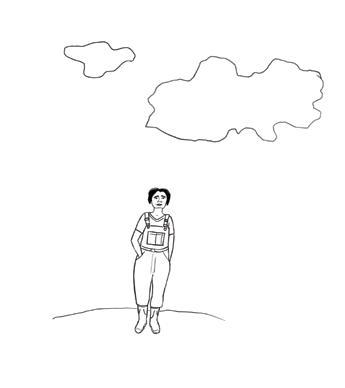
by MaryBeth Barker
With a tough exterior, rigid stalk, and telling name, Rattlesnake Master sways mightily in the prairie breeze. The heads give the plant its identifying look. Spikes poke out from a white sphere, flowering into miniature inflorescences that extend to nearby pollinators.
I let my hands linger on these ridges. The plant stands out in the prairie, as if it has flown in from somewhere far off: the desert, a different planet. Its name even sounds otherworldly: Eryngium yuccifolium. Despite its appearance, its name, I know it belongs where I stand. Forty years ago, I planted its seed in the ground.
When I bought my first home back in 2033, I was ecstatic. There was land, there were rooms for me to fill with books, furniture, with life. A place of my own to create. To purchase any home in the economy back then felt like a miracle. This particular home had been taken off of the electric grid after endless sunspots had rendered it too expensive to continue powering. This, I knew, was my chance to take.
Outside, an old farm field had been left to the weeds. This would become my main project, after I set up solar
power and made the house more livable. It became my goal to return it back to its original tallgrass prairie.
The first year I threw seed onto the land, nothing grew back except the weeds, stronger than ever. In the second year I spent hours digging and hacking at them, creating space for the second round of native seeds to make a home. The third summer, I sang and danced at the sight of a violet. After that, I learned that native plants respond positively to frequent fire, and that spring I mowed fire breaks all around the plot, picked a day with the right wind speed and direction, and used an old propane torch to safely light it off. Two years later, black eyed susan, bee balm, coneflower, and mountain mint all thrived among the weeds. Every summer I pulled the unwanted plants out of the ground. Every three springs I burned it. In the winter I removed invasive brush out of the woodland adjacent. It took ten years for the prairie to establish, and another ten to stay that way without my help.
Every year I included Rattlesnake Master in my seed mix, but for twenty years, it never germinated. After many attempts, I stopped purchasing
the seed, and figured the soil of my prairie simply was not habitable to the species.
There were often young kids from neighboring houses who played and frolicked in the tall grass and blooming wildflowers. They biked to my backyard and chased butterflies, looked under rocks for blue spotted salamanders, and splashed in the creek that meandered through the woods. It was a thriving community for plants and people alike. I had succeeded in my part, and as I grew old, I let the prairie take charge.
Today, as I watch pale spheres on a long dry stalk bobbing back and forth in the wind, I remain in awe of the world and everything it is capable of. Perhaps the seed blew in from a nearby restoration project. Perhaps this specific plant simply needed a germination period of 20-40 years. It looks expectantly at my wrinkled hands, my crouching back, as if asking: when will you bloom?
I already have… I already have.
MaryBeth is a restoration ecologist and prescribed fire practitioner based in Madison, WI.
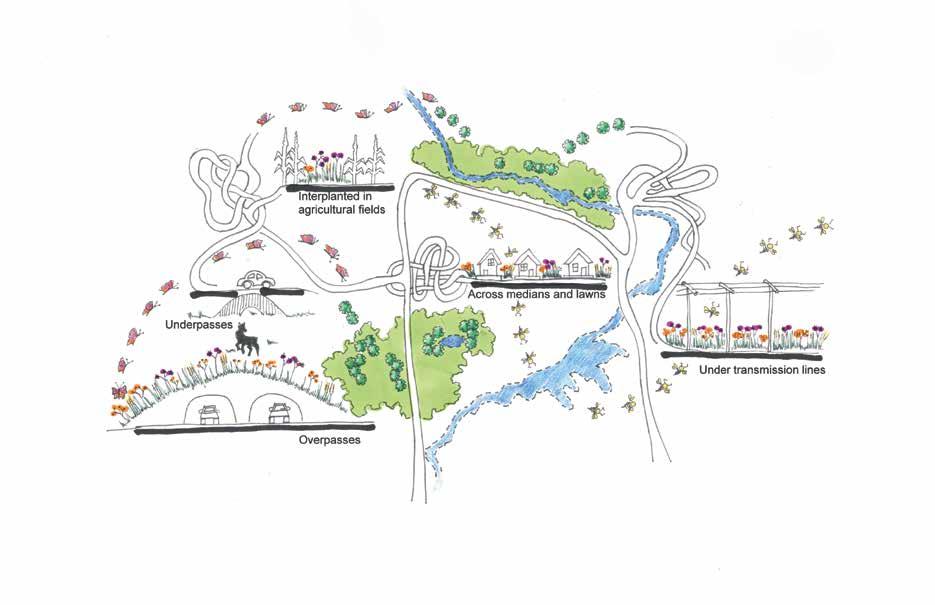

"I want to quarrel with your opposition of culture and nature. Culture is always cultivated nature — nature being tended and being taken care of by one of nature’s products called man. If nature is dead, culture will die too, together with all the artifacts of our civilization."
—Hannah Arendt

by Dr. Kevin Koch
To our north lies the great state of the Northern Glacial Plain, and to our south and west lies the newly minted Tallgrass Prairie State. You’ll notice contoured farm fields when driving across our own Driftless Land, the youngest of our nation’s states. We learned here long ago that trying to overcome hills and valleys with straight rows leads only to erosional loss of our most precious resource, the soil. But working with the landscape—curving and rippling our plowed fields around the contours of the hillsides—results in mutual benefits to the land and our well-being. The hilly landscape encourages other innovations as well: the Driftless Land hosts the highest concentration of organic farms in the nation.
Rock outcrops, road cuts, and sheer bluffs are prominent. Wind- and water-hewn sandstone with its

colored swirls inspires us to imitate nature’s creativity in our own individual ways. Limestone with its embedded fossils reminds us that even though life is short, it is also long, and we need to keep grounded through the ages.
Limestone teaches us to tend to our inner lives. Soluble by water over time, limestone bedrock harbors deep interior caves and recesses adorned with fantastical stalactites, stalagmites, and other calcified formations. Underground streams run undetected beneath our feet. The wonder of such caves is seldom seen, sometimes never at all. Let such spaces remind us of our own interior beauty and mystery.
From these hidden recesses flow spring waters that form sparkling streams and join forces with existing rivers. Trout grace our Driftless creeks. The Wisconsin River still pushes along sand deposited from an ice dam break near the end of the most recent glacial period 12,000 years ago. The Mississippi River originates far north of our Driftless state and travels far south of our borders, but within the Driftless it too reminds us of the melting of that long-ago glacier. The Mississippi once ran brim to brim between its 300- and 400-foot bluffs when the meltwaters came scouring down. All these Driftless waters remind us that while we are products of our past, which accumulates here like forest hummus atop the deep bedrock, we also remake ourselves anew.
Kevin is a nature writer, retired educator, and the author of four books including Midwest Bedrock.

I hope there are birds. Chickadees that hop, squeak, are gone, winged puffs, White-breasted nuthatches earnestly asking what, what, what,
Trumpeter swans silently circling, jewel flash
Of blue bird, downy woodpeckers drumming, Robins, the first to sing, egrets in marsh, so white and still,
Great blue herons drifting over the river, bluish mourning
Doves lined up like sorrows on metal wires, cooing,
Owl screams splintering dream-thick
Darkness, hawks fierce as fence posts,
Cranes, long-legged foragers, floating onto cornfields, rummaging
In black soil. I hope you found love
If you wanted it, raised a child if you
Wanted one, and that your child is strong
Like you. I hope you wake to bird song, love your work
Like a farmer looking up from her fields, birds
Swoop, sky shine in feathers,
Bright soft eyes, and weathered skin. I hope grackles
Gleam and cackle in treetops, that you have knelt in
Loamy soil and pulled out something sweet to eat.
I hope the rains fall, starlings flock and swirl overhead
And you tilt your face to watch this flight, this shimmer.
—Aurelia Wills
Aurelia is a writer based in Saint Paul, MN and the author of Someone I Wanted to Be.

An April thunderstorm just rolled through. It’s 3 AM, but sleep just doesn’t come as easily now that I’m in my 80s. So here I sit, sentimental farmer that I am, sifting through a box of old thank you notes. Sam, who raised veggies for 40 years, passed away recently, and her son wanted me to have these. Here’s one my husband Nate and I sent when we were just 10 years into farming: Sam, I know you said it was no big deal, but honestly you saved our tails.
That fall, right at butcher time, Nate and I got Covid and it knocked us flat. Turkey pickup day was our biggest money-maker, and we had 109 folks signed up! The day was so long—five pickup sites around southeast Indiana and we

by Liz Brownlee
had to get it all right. We were dog-tired, our brains were foggy, and there was just no way we could pull this off alone. So we reached out to our farmer friends for help, and Sam and several others came through.
I remember that night thinking how beautiful it was, that our friends showed up for us. I was still a little embarrassed about asking for help, but reassured myself by thinking the next time they needed a hand, they might feel a little more comfortable asking.
And they did! Over time, we gave each other permission to need. We were all a little hesitant at first. Asking for help was something we had to practice. But as we got more comfortable, we saw we were stronger, better, happier together. I bet we all have a box like this, full to the brim. I’ll read a few more before I turn out the lights:
Sam, The farmhouse is finally done! Years of work, mostly alone, capped by this big push of folks painting and laying floors and building the deck. Let’s just say my cup is full.
Sam, Thanks for pushing me to host that field day. I wasn’t sure I had much to say, but once we all got to talking and walking the farm, it was actually fun. The organizers had to cut me off so we could end the tour and go eat dinner!
Here’s one still in the envelope. Maybe Sam just decided to say it in person: Mike, It meant the world for your band to play at our fundraiser. We were brokenhearted when the barn blew down, but seeing so many people chip in to help rebuild—well, it means we can keep farming.
Sam, Thanks for the bitch session. We moved a lot of mulch while we talked, and I feel a little better. Next time let’s do it at your place.
Liz and her husband Nate run Nightfall Farm in southern Indiana, where they raise livestock on pasture.

In Tigro’s dreams he could see his grandfather standing behind him with his two siblings: they were black puma-jaguars and also plants. Humans, with some exceptions, could not see the transformations. They were unable to see beyond their daily realities. Perhaps that is why they disappeared. The last time they had eaten human flesh was so long ago it seemed almost unreal. The last day Tigro
En los sueños de Tigro podía ver a su abuelo parado detrás de él con sus dos hermanos, eran pumas-jaguares negros y también plantas. Los humanos, sin embargo, salvo algunas excepciones, no pudieron ver las transformaciones. No pudieron ver más allá de sus realidades cotidianas. Quizás por eso desaparecieron. La última vez que habían comido carne humana estaba muy lejos y casi

Today’s Community Kitchen suggested recipe has been adapted from the 2044 classic Food for Humans by Alexis Nikole Nelson and Nathan Myhrvold. Portions have been adjusted upwards from 4 to 200 servings, and some ingredients have been substituted based on the 2070 Global Resource Advisory Institute for Nutrition & Sustainability (G.R.A.I.N.S.) report.

This simple salad highlights how peppery and sweet raw kohlrabi is, particularly after it has spent some time in the cold. Either purple or green kohlrabi is fine for this dish, but a mix of the two gives the best appearance. Select the smallest kohlrabi available for the most pleasant raw texture. Large or woody kohlrabi can be set aside and should be stewed, roasted, or fried.
All listed ingredients are on your regional ag green flag list. If you have trouble sourcing, please contact the Community Kitchen hub in Madison for support.
Ingredients
25 kg kohlrabi, peeled and trimmed
5 kg arugula
10 kg citric apples (any variety will work, although one bred for raw consumption, like a Clyde Yellow or Kanzi, will have the best texture)
6 kg crème fraîche
1.2 kg dried garlic mustard seeds
0.75 kg sumac vinegar
0.75 kg sunflower oil
0.10 kg garum*
0.20 kg halophyte powder
*It’s a great idea to use a locally produced garum for this. Our records show soy, fermented pig heart, or grasshopper based garums are produced within your catchment. But if you wish to use traditional fish sauce, it is on the pre-approved culinary exchange list.
Directions
Cut the kohlrabi and apples into equal sized segments about 6 mm wide on the thick side. Toss the kohlrabi with half of the crème fraîche, garlic mustard seeds, and halophyte powder.
Vigorously toss the apple segments with the vinegar and oil, agitating enough to express some juice from the apples, then mix in the arugula.
Keep the kohlrabi and apples apart until serving. At that point, plate the apples and arugula, top with kohlrabi, then drizzle additional crème fraîche and sprinkle more garlic mustard seeds on top.


Keith Burrows is a writer and scientist who runs The Republic of Letters Bookstore in Mineral Point, WI with his wife Leslie.

Welcome back from the moon— It waned while you were away. I waved. I said, Hello, You, on the moon. Your weeks traveling, they were weeks here too.
While you were gone, I went looking for Deep Time:
I scrabbled up a sandstone bluff path and traced the layers with my hand and eye, the lifted and shifted and compressed, here, here, here. In the crumble and stratified: 500 million years.
And the purpled quartzite along a nearby trail, tinged ruddy, rosy, the hematite-hued? I passed a 1.5-billion-year-old pebble back and forth between my palms.
The next day I walked along the sandy bottom of the river, startling a spiny soft-shelled turtle with my shadow. Hello, Apolone spinifera, snorkel nose above the water line. You appeared ageless: your ancestors arose 50 million years ago.
I wanted to be very lucky and see a prehistoric paddlefish, 300 million years old, old as the dinosaurs. I did not.
I floated in the river instead, ears tuned, mulling to the sound of small rocks clacking, tumbling in the current. I listened to my slow inhale, exhale. Whooper, crane.
Cumulus—timeless, ethereal, above.
—Sara Greenslit
Sara lives and writes in Madison, WI where she is a small animal veterinarian.
